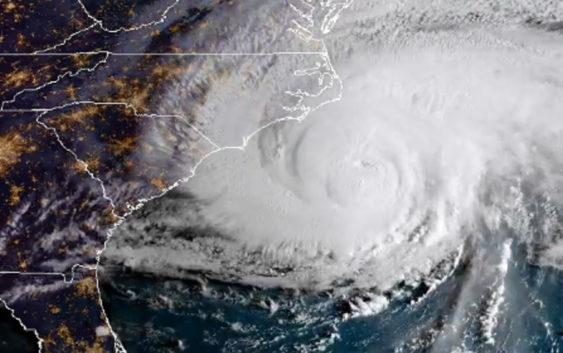- 'A little emotional': Hurricanes equipment manager got seconds in goal, memory to last a lifetime
- WMO retires three hurricane names after devastating 2024 season
- Beryl removed from future hurricane naming lists
- Hurricane names Helene, Milton and Beryl are now retired
- Hurricane Helene's name retired after deadly 2024 impact on US
Hurricane Florence’s winds and rain begin lashing Carolinas

MYRTLE BEACH, S.C. (AP) — The outer bands of wind and rain from a weakened but still deadly Hurricane Florence began lashing North Carolina on Thursday as the monster storm moved in for an extended stay along the Southeastern coast, promising to drench the homes of as many as 10 million people with immense amounts of rain.
Florence’s top sustained wind speeds dropped from a high of 140 mph (225 kph) to 110 mph (175 kph) early Thursday. That reduced Florence from a Category 4 to a Category 2 hurricane, but forecasters warned that the widening storm — and its likelihood of lingering around the coast day after day after day — will bring surging ocean water and torrential rain.
“It truly is really about the whole size of this storm,” National Hurricane Center Director Ken Graham said. “The larger and the slower the storm is, the greater the threat and the impact — and we have that.”
As of 8 a.m. EDT it was centered about 170 miles (275 kilometers) east-southeast of Wilmington, North Carolina and about 220 miles (355 kilometers) east-southeast of Myrtle Beach, South Carolina, moving northwest at 12 mph (20 kph). Hurricane-force winds were blowing 80 miles (130 kilometers) from its center, and tropical-storm-force winds reached up to 195 miles (315 kilometers) from the eye.
The hurricane center’s best estimate was that Florence’s eye would blow ashore as early as early Friday around the North Carolina-South Carolina line. Then, it will likely hover along the coast Saturday, pushing up to 13 feet (nearly 4 meters) of storm surge and dumping water on both states. The forecast calls for as much as 40 inches (102 centimeters) of rain over seven days along the coast, with the deluge continuing even as the center of the storm slogs away over the Appalachian Mountains.
The result: catastrophic inland flooding that could swamp homes, businesses, farm fields and industrial sites.
About 5.25 million people live in areas under hurricane warnings or watches, and 4.9 million more live in places covered by tropical storm warnings or watches, the National Weather Service said.
Weather Underground meteorology director Jeff Masters said Florence eventually could strike as a Category 1 with winds less than 100 mph (160 kph), but that’s still enough to cause at least $1 billion in damage. Water kills more people in hurricanes than wind, and the rain and storm surge will make Florence extremely dangerous.
President Donald Trump both touted the government’s readiness and urged people to get out of the way. “Don’t play games with it. It’s a big one,” he said at the White House.
It’s unclear exactly how many people fled, but more than 1.7 million people in the Carolinas and Virginia were warned to clear out. Airlines canceled nearly 1,000 flights and counting. Home Depot and Lowe’s activated emergency response centers to get generators, trash bags and bottled water to stores before and after the storm. The two hardware chains said they sent in a total of around 1,100 trucks.
Duke Energy, the nation’s No. 2 power company, said Florence could knock out electricity to three-quarters of its 4 million customers in the Carolinas, and outages could last for weeks. Workers are being brought in from the Midwest and Florida to help in the storm’s aftermath, it said.
Boarding up his home in Myrtle Beach, South Carolina, Chris Pennington watched the forecasts and tried to decide when to leave.
“In 12 or 18 hours, they may be saying different things all over again,” he said.
Computer models of exactly what the storm might do varied, adding to the uncertainty. Reacting to the possibility of a more southerly track, Georgia Gov. Nathan Deal declared an emergency but did not immediately order any evacuations.
“I ask all Georgians to join me in praying for the safety of our people and all those in the path of Hurricane Florence,” Deal said.
In Virginia, where about 245,000 residents were ordered to evacuate low-lying areas, officials urged them to stay in safer locations despite forecast changes showing Florence’s path largely missing the state.
With their entire neighborhood evacuated in Wilmington, North Carolina, David and Janelle Garrigus planned to ride out Florence at their daughter’s one-bedroom apartment in Charlotte. Unsure of what they might find when they return home, the couple went shopping for a recreational vehicle.
“We’re just trying to plan for the future here, not having a house for an extended period of time,” David Garrigus said.
Melody Rawson evacuated her first-floor apartment in Myrtle Beach and arrived at Atlanta Motor Speedway in Hampton, Georgia, to camp for free with three other adults, her disabled son, two dogs and a pet bird.
“We hope to have something left when we get home,” she said. Three other Southern raceways also opened campgrounds to evacuees.
Forecasters worried the storm’s damage will be all the worse if it lingers on the coast. The trend is “exceptionally bad news,” said University of Miami hurricane researcher Brian McNoldy, since it “smears a landfall out over hundreds of miles of coastline, most notably the storm surge.”
With South Carolina’s beach towns now more in the bull’s-eye because of the shifting forecast, Ohio vacationers Chris and Nicole Roland put off their departure from North Myrtle Beach to get the maximum amount of time on the sand. Most other beachgoers were long gone.
“It’s been really nice,” Nicole Roland said. “Also, a little creepy. You feel like you should have already left.”